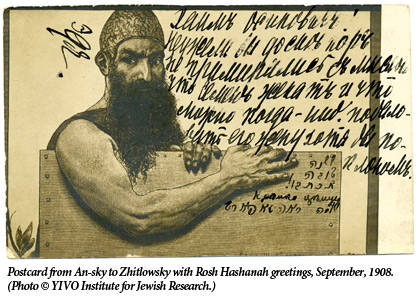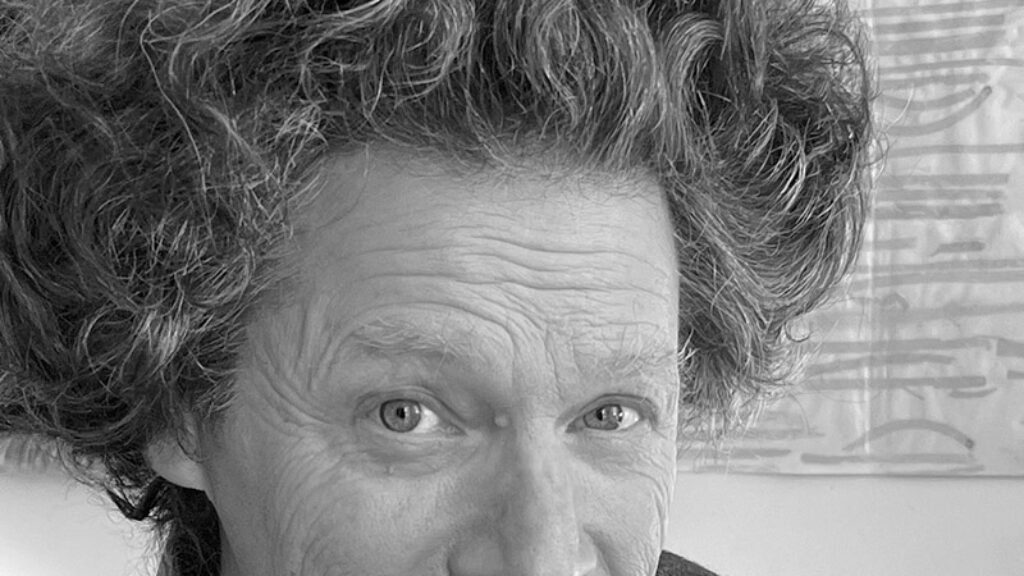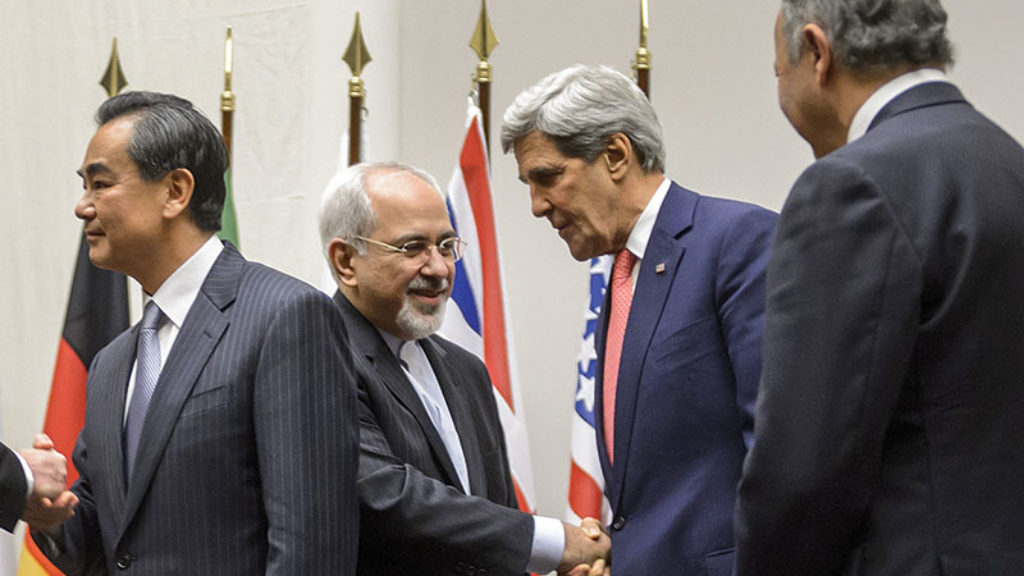Sole Searcher
What do we make of S. An-sky, this towering public intellectual—this Russian-Yiddish writer, pioneering ethnographer, champion of lost causes—a century and a half after his birth? When he died in 1920, escaping the Bolsheviks, his play The Dybbuk had not been staged in any language. His three-volume account of Jewish catastrophe in World War I remained in manuscript, and the artifacts he had collected for his Jewish museum in Petrograd were threatened with confiscation. In time, of course, a lot changed. The Dybbuk, in Bialik’s Hebrew rendering, became the foundational play of Israel’s Habima National Theatre, and continues to be staged in many languages. After the fall of the Soviet Union, the basement of the St. Petersburg Ethnographic Museum yielded objects from his collections. Photographs from his expeditions turned up in someone’s apartment. And now his life has become the subject of a marvelously detailed biography by Gabriella Safran. Watching An-sky in context, we can start to understand what he was and what he meant.
An-sky (originally Shloyme-Zanvl Rappoport) was born in 1864 in a shtetl outside of Vitebsk. That he chose a pseudonym for public life is hardly surprising; even Russians did it. But Russian family names aren’t bisected by dashes, unless they appear in novels whose authors want to obscure something: “In the provincial town of N-, a certain N-sky . . .” An-sky obscured a great deal. For a biographer, the biggest gap concerns his private life. He married twice, briefly and unhappily, and eventually came to define himself as a man alone. It could be, as Safran suggests, that he was homosexual; it could be that he was following a model of the Russian radical as ascetic. Whatever private choices he made, he acted in public precisely as he later confessed: “I have neither a wife, nor children, nor a house, nor even an apartment, nor belongings, nor even any settled habits . . . the only thing that connects me firmly to these dimensions is my nation.” An-sky’s devotion to his nation was intense and even courageous. But it took a while to mature.

An-sky’s upbringing was poor; his father was an itinerant businessman, his mother kept a tavern. In Vitebsk, he met Chaim Zhitlowsky, another future champion of Diaspora Jewry. The young Zhitlowsky had what An-sky did not: a privileged background, with the education that seamlessly followed. The two of them read rebellious books in Hebrew and Russian and smoked cigarettes on Shabbat. At 17, An-sky left for nearby Liozno, a small, mostly Jewish town, where he gave private lessons in Russian. For a time, he succeeded in concealing his modern views from parents while enlightening their children, but he was eventually unmasked. What did him in was not his scorn for the world around him (“the shul was like a stable where there are horses,” he wrote Zhitlowsky), but the discovery of a copy of Moses Leib Lilienblum’s incendiary Chataot Neurim (Sins of Youth) in the hands of one of his pupils. Expelled from Liozno, he took a turn at blacksmithing and bookbinding, and wrote a Yiddish novel reflecting ideas about Jewish transformation through labor and self-assertion. The novel was translated into Russian and appeared (anonymously) in the Russian-Jewish monthly Voskhod. The other half of the equation, labor, led him to a job in a salt mine where he was the only Jew among Russian peasants. The mine was his first raw experience with peasants, albeit peasants who had left the land for non-agricultural work. As a reader of Russian literature, An-sky was primed to sympathize with them. And they in turn accepted him; they never saw him as a Jew, and gave him a Russian name and patronymic, Semyon Akimovich, that he used until the end of his life. In a pattern that would repeat itself many times, An-sky became both activist and ethnographer. He read to the miners, wrote letters for them, and collected their songs—something no one else had ever done before.
An-sky’s immersion in these people’s world was the practical side of his political and philosophical association with the radical, socialist (though not Marxist) Russian populist movement. Like An-sky, populists saw folk traditions as virtuous and authentic. A darker side of their agenda was violence: both the late 19th-century People’s Will party and the early 20th-century Social Revolutionaries (SRs) engaged in political assassinations, which they called “terrorism.” An-sky, an SR for many years, by and large endorsed political terror as an anti-tsarist act.
In the decades before the Revolution of 1905, An-sky was absorbed in Russian affairs. He found a mentor in the writer Vladimir Uspensky, who invited him to St. Petersburg without thinking of where a Jew without a residence permit would spend the night. Out for a stroll hours after dispatching his guest, the insomniac Uspensky discovered him walking the streets. He brought An-sky back to his house, and eventually introduced him to the populist intelligentsia. An-sky began writing for Uspensky’s journal Russkoe Bogatsvo. He had arrived.
When Uspensky had to be hospitalized, An-sky decamped for Europe. In Paris he attained the position for which he remains best known among Russians: private secretary to the populist theoretician Pyotr Lavrov. But in Bern later that year, he grew close enough to the Bund-despite that movement’s Marxism-to write two Yiddish poems, “In the Salty Sea of Human Tears” and a new version of the already familiar poem “The Oath” that were set to music and became party anthems. He also began to write Jewish fiction. For Voskhod, he wrote the story “Pioneers,” about young men poised between Jewish texts and the Russian intellectual world they want to join. For the Yiddish daily Der Freynd, he wrote a long poem about a girl who, repenting after her abduction by a demon, is rejected by both the modern world and the traditional one.
The Revolution of 1905 brought him back to Russia, eager to play a part in the inauguration of a new era. But the events of 1906 and 1907 and above all the pogroms-the broken lives, the “spineless” response of revolutionary parties, and the indifference or collusion of the government-induced him to retreat both from the idea of political terror and from politics. He recovered from “the trauma of the failed revolution,” as Safran puts it, by devoting his energy to research and writing on Jewish folklore. Nevertheless, she stresses, “when he devoted himself to Jewish literature and ethnography, he was not turning away from his older revolutionary convictions or his loyalty to Russian intelligentsia values . . . An-sky was motivated, as he had always been, by the need to find soil where he could feel that he was accomplishing something and improving people’s lives.” An-sky saw folk tradition as embodying Jewish ethics, notably the elevation of the spiritual over the physical. Involvement in Jewish culture was, for him, Safran suggests, “primarily the choice of a more effective means to continue his struggle for justice.” But it also afforded him “the opportunity to see himself as heroically devoting himself to those who needed him, and the self-forgetting ecstasy he found in connections with other people.”
For his groundbreaking ethnographic expedition through the Pale of Settlement in 1909 he made careful plans, developing questionnaires and detailing the kinds of oral texts he sought, along with “customs, beliefs, charms, superstitions, remedies” and material objects. A wealthy Kiev businessman, Baron Vladimir Gintsburg, gave him seed money, and An-sky, in thoroughly modern fashion, named the project after the Baron’s famous father, who had just died.
An-sky set out with the musicologist Yuly Engel and a young relative, the photographer Solomon Iudovin. Despite some problems—they discovered, for example, that children who were paid five kopecks per song were making songs up on the spot—they collected thousands of texts on the verge of disappearance and put Jewish ethnography on a serious scholarly footing. In 1914, objects from the expedition went on display in a St. Petersburg Jewish almshouse: Russia’s first Jewish museum.

An-sky’s goal of revitalizing Jewish culture by fusing folklore with high art was realized in his play The Dybbuk, which unites the conventions of romantic tragedy with Jewish folk exotica: a lost soul that possesses a young bride, and a rabbinical court that judges both the living and the dead. It’s not surprising that the director Konstantin Stanislavsky compared the play favorably to those of the then-fashionable symbolist Maurice Maeterlinck, or that the Russian symbolist Fedor Sologub declared it “true and unique.” But the play was not staged in An-sky’s lifetime. Both author and audience fell victim to a larger historical drama: a world war and two revolutions.
Within six months of the outbreak of war, reports of the destruction of Jewish communities in the war zone began to reach the capital. The Jewish Committee to Help War Victims was already in existence, and An-sky drafted himself as an aid worker. Now, as Safran relates, he faced daily evidence that the violence against the Jews was the work of Russian soldiers. He sought to understand what corrupted them, only to hear the rationalizations about Jewish treachery from liberal intellectuals. Along with I. L. Peretz and Yankev Dinezon, he put out an appeal to Jews to make a record of the catastrophe. He himself collected over a thousand documents.
In February 1917, the tsar abdicated. Among the groups now jockeying for political power were An-sky’s own SRs, plus the centrist-liberal Kadets with whom he had worked in war relief. He knew Alexander Kerensky and the other leaders of the Provisional Government personally and was himself elected to the Petrograd City Duma as an SR. But his engagement in Russian politics did not mean disengagement from Jews. He began raising money for a forty-volume collection of materials from his expedition and assembled subscriptions for a volume of Jewish art. He arranged for the Hebrew publication of The Destruction of Galicia, which was his own account of the misery he had witnessed. But again, history swept away his plans. The night of the Bolshevik Revolution found him at the Tsarsko-Selsky railway station, on his way back from Mogilev. He raced to the City Duma, and became part of a committee to negotiate power-sharing with the Bolsheviks. That came to nothing, as did his election to the Constituent Assembly, the parliament famously dissolved by Lenin during its opening session.
On August 30, 1918, the SR Fanya Kaplan made an attempt on Lenin’s life. The Cheka started arresting SRs, indiscriminately and in massive numbers. An-sky fled Moscow, leaving behind a manuscript of The Dybbuk and his wartime diaries. He settled in Vilna, where he became a founding member of its Jewish Historical-Ethnographic Society, and a new branch of the Jewish Committee to Help War Victims. But Vilna itself became embroiled in conflict, with pogroms inflicted by Poles, Whites, and, though to a lesser degree, Bolsheviks. Ill with diabetes and suffering from the heart condition that would take his life, An-sky left for Warsaw.
Safran doesn’t want An-sky’s story to be a narrative of return. But even as we accept his multiple loyalties, and even as we weigh the harrowing pressures of his final years in war and revolution, a story of return is what it seems to be. He starts out as an adolescent maskil surrounded by “pigs.” Captivated by Russian populism, he lives with miners and becomes a revolutionary. Gradually, he rethinks his loyalties to Jews, becoming a Jewish writer in Yiddish and Russian, a profoundly committed ethnographer, an aid worker in wartime, and a documenter of Jewish catastrophe. In the end, as Safran observes, “he acknowledged the limits of the dream of radical change that had motivated him for so long.” But even during the very last days of his life, in November 1920, he could still write letters in which he happily notified his friends of the founding of a new Jewish Historical-Ethnographic society in Warsaw.
Suggested Reading

Life on a Hilltop
City on a Hilltop is superbly researched, altogether accessible, and will dispel many lazy stereotypes about the people whose story it tells. But it leaves out a lot.

Tangled Truly
Letters of ink. Letters of the heart.

Palestine Portrayed
The 1948 War and the problems it left unresolved have returned to the top of the agenda for both diplomats and historians.

Of Spies and Centrifuges
Jay Solomon traces decades of spy games between the United States and Iran, a conflict, he writes, “played out covertly, in the shadows, and in ways most Americans never saw or comprehended.”
Comments
You must log in to comment Log In